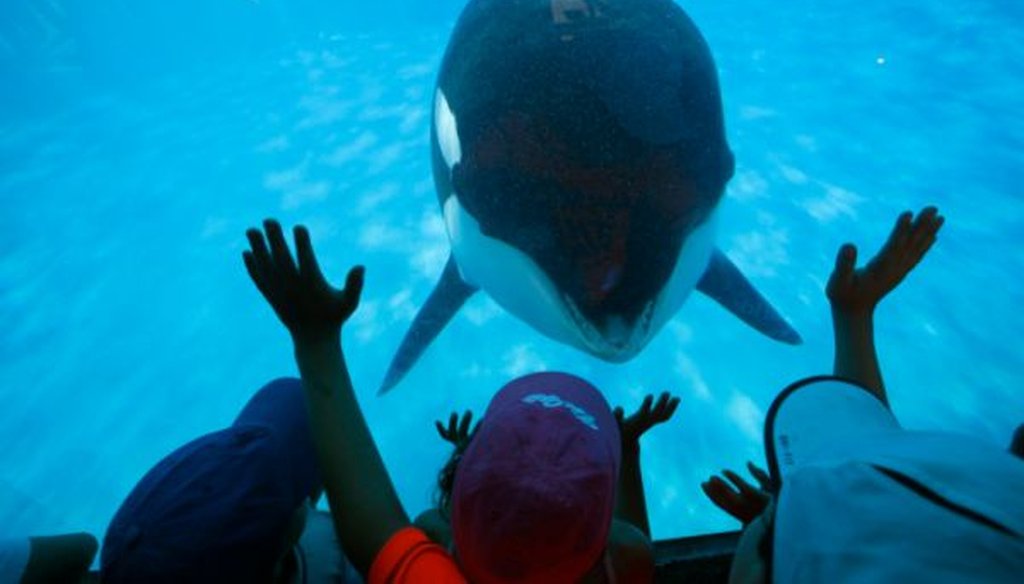Get PolitiFact in your inbox.

SeaWorld San Diego visitors get a closeup view of an orca through a window at the park on Aug. 14, 2014.
SeaWorld says their whales live as long as wild whales do
More and more, critics are making the case that keeping killer whales in captivity is harmful to the animals and dangerous for the people who train them. SeaWorld, the theme park that showcases the trained whales, is now fighting back.
A new ad, part of a multimedia blitz for the company, is headlined, "Fact: Whales live as long at SeaWorld," and it is written in the voice of Chris Dold, a SeaWorld veterinarian. The ad, which has appeared in the Tampa Bay Times, takes specific aim at criticism leveled by People for the Ethical Treatment of Animals, or PETA, an animal-rights group that has been among the theme park company’s biggest critics. Here’s a portion of the ad’s text:
"You might have heard attacks from PETA saying our killer whales live only a fraction as long as whales in the wild. They say, ‘In captivity, orcas’ average life span plummets to just nine years.’ But the author of an independent study, Dr. Douglas DeMaster, of the Alaska Fisheries Science Center, was quoted in the Wall Street Journal as saying, ‘Survival in the wild is comparable to survival in captivity.’ There’s no other way to say it… PETA is not giving you the facts."
PETA, meanwhile, pushed back against the ad’s conclusions, citing the average age of whales that have died since 1965. According to PETA’s documentation of captive whale deaths, the average age of death is 12 years old for SeaWorld’s female orcas -- which are expected to survive in the wild for about 50 years. For males -- which are expected to survive in the wild for 30 years -- the average age of death is 16.
SeaWorld currently has in its care several whales in their 30s and one in its 40s.
Keeping whales in captivity is a complicated issue, and the critical 2013 documentary Blackfish has brought more attention to it. Clearly, longevity is just one factor, and it isn’t the same thing as the quality of the whales’ daily lives. Here, though, we wanted to drill down on SeaWorld’s specific claim that the whales at their parks live just as long as they do in the wild.
SeaWorld’s evidence
We posed SeaWorld’s claim to DeMaster, the scientist quoted in the ad. He’s the science director of the Alaska Fisheries Science Center, an office of the National Oceanic and Atmospheric Administration, a federal government agency. Most of the independent experts we contacted agreed that DeMaster is the key scientist to ask about this issue.
DeMaster said that SeaWorld is correct -- "as long as you use data from 2005 to 2013." (PETA’s data, by contrast, goes back 40 more years.)
On three occasions -- in 1988, 1995 and 2013 -- DeMaster has compiled data that comprehensively compared survival among captive and wild marine mammals.
In the 1988 and 1995 papers, DeMaster found differences in the survival rates of marine mammals, including killer whales (also called orcas), depending on whether they lived in the wild or in captivity. The 1995 paper, for instance, found that captive orcas had a 94 percent chance of surviving to the next year in captivity, compared to 98 percent in the wild.
That changed by the time DeMaster completed his latest research, in 2013. By then, he found, the annual survival rate for both captive and non-captive killer whales had converged at 98 percent.
"According to recent information there was an improvement in the annual survival rate, to quite close to what you might see in the wild," DeMaster told PolitiFact.
DeMaster cautioned that he’s not sure of the reason for the improvement in survival, and he said he doesn’t take a position on whether or not large mammals should be kept in captivity.
Meanwhile, an Associated Press analysis also cited in the SeaWorld ad -- which is based on the same data DeMaster used, the federal government’s Marine Mammal Inventory Report -- found that the average life expectancy for a killer whale born at SeaWorld was 46 years, which it said was close to the 49-year average life expectancy of a wild orca.
Critiquing the SeaWorld evidence
So SeaWorld has support for its claim. But the company glosses over some important caveats.
• None of the statistical comparisons take into account quality of life, as opposed to length of life. Science is better at measuring longevity than it is at judging how humane a life in captivity is.
The mathematical approach "is totally irrelevant," said Dave Duffus, an associate professor of geography at Canada's University of Victoria, who participated on the panel with DeMaster in New Zealand. "To me the important variable is not how long, rather it is how well, which isn’t a scientific question as much as it is a logical question. Everything about the quality of captive life is in opposition to the wild, which is the product of thousands of generations of natural selection."
• Merely reaching parity with wild populations isn’t necessarily a major achievement. Simple logic would suggest several reasons why marine mammals should live longer in captivity. Captive animals don’t have to worry about predators, food shortages, fishing nets, or pollution, and they’re given nutritional supplements, vaccines and veterinary care.
"It would sort of make sense that any animal given better medical and nutritional care would live just as long, or longer, than one not given this sort of care," said Paul Nachtigall, director of the Marine Mammal Research Program at the University of Hawaii.
• The ad focuses on longevity, not survival rates; those are different statistics. The ad’s headline refers to how long whales live, and the text uses terms like "life span" and "life expectancy." But those are different things than the statistic DeMaster used that’s favorable to SeaWorld -- annual survival rates.
Many experts, including DeMaster, told PolitiFact that annual survival rates are better measurements than longevity. Whales have not been in captivity long enough to know whether they are able to live a full-length life in that setting, DeMaster told PolitiFact. They’ve only been in captivity since the 1960s.
Jaap van der Toom, a Dutch biologist who has studied marine mammals, has made a similar point. "Longevity is basically an incidental finding: it is determined by the oldest animal you find in your sample," he has written. "You can only determine the longevity of a group of animals after all the members of that group have died."
Well before SeaWorld released its ad, van der Toom published a cheat sheet about how to spin statistics. Referring to the same group of animals, he said, you could use different statistics to paint opposite appraisals. "If you want to paint a positive picture," you could say that "the life expectancy is 19.5 years" or "the majority of the animals will become older than 13 years," he wrote. In effect, that’s the approach SeaWorld took. But if you wanted to offer a negative spin, you would say that "within five years, 23 percent of the animals will have died," or that "one-third of the animals will survive no longer than eight years," or "within 14 years, 50 percent of the animals will be dead."
Van der Toom summed up: "To paraphrase an old song: " ‘t ain't what you say, it's the way that you say it."
• The data on wild orca populations is sparse. There is data on whale life spans from the Pacific Northwest, but there are orcas all over the world, and there’s no guarantee that all of them have similar life spans and survival rates.
In the 1995 paper, DeMaster cautioned that "comparisons between survival in captivity with survival in the wild will remain tenuous until additional demographic studies are conducted on wild populations."
Our ruling
A SeaWorld ad said "whales live as long at SeaWorld" as they do in the wild.
At its core, this claim is an oversimplification of a much more complex issue. Recent independent data suggests that survival rates for captive and wild orcas are about equal, but that by itself isn't all that significant, experts told us. The data is limited and comparisons between orcas in captivity and in the wild are tenuous. Experts also noted that logic suggests captive whales should live longer because they don't face predators and receive medical care, which makes SeaWorld's claim further misleading.
Lastly, experts said that a simple measurement of survival rates (or lifespan) serves as a smokescreen from the more fundamental question of the conditions for whales in captivity.
The statement is partially accurate but leaves out important details, so we rate it Half True.
Our Sources
SeaWorld advertisement, March 24, 2015
Tampa Bay Times, "SeaWorld launches ad campaign after backlash from 'Blackfish,' " March 24, 2015
WLTZ, "New SeaWorld Advertising Campaign Highlights Leadership In Killer Whale Care, Counters Misinformation," March 23, 2015
Small, RJ and DP Demaster. "Survival of five species of captive marine mammals" (Marine Mammal Science), 1995.
Douglas P. DeMaster and Jeannie K. Drevenak, "Survivorship Patterns in Three Species of Captive Cetaceans" (Marine Mammal Science), 1988
A. Mel Cosentino, "Panel discussion: Scientific studies of captive and free-living killer whales," Dec. 9-13, 2013
J.D. van der Toorn, "A survival guide to survival rates," 1997-2000
Orlando Sentinel, "SeaWorld, activists make questionable claims on killer-whale life spans," Jan. 25, 2014
Wall Street Journal, "Activists Step Up Campaign Against SeaWorld Over Killer Whales," July 18, 2014
Associated Press, "Some SeaWorld mammals survive longer in captivity," July 3, 2014
SeaWorld, "Killer Whale Care," accessed March 24, 2015
PETA, "Lives Stolen By SeaWorld," 2013
Naomi Rose, "Killer Controversy: Why orcas should no longer be kept in captivity" (Humane Sociey International/Humane Society of the United States), September 2011
The Dodo, "Everything Wrong With SeaWorld's Claims About Orca Lifespan," May 22, 2014
Email interviews with Becca Bides and Fred Jacobs, spokespersons for SeaWorld, March 24, 2015
Phone interview with Jared Goodman, PETA director of animal law, March 23, 2015
Phone interview with Doug DeMaster, science director of the Alaska Fisheries Science Center, March 23, 2015
Email interview with Dave Duffus, associate professor of geography at Canada's University of Victoria, March 23, 2015
Email interview with Paul Nachtigall, director of the Marine Mammal Research Program at the University of Hawaii, March 23, 2015
Email interview with Jill Richardson, director of the Masters of Professional Science program at the University of Miami’s Rosenstiel School of Marine and Atmospheric Science, March 23, 2015
Browse the Truth-O-Meter
More by Lauren Carroll
SeaWorld says their whales live as long as wild whales do
Support independent fact-checking.
Become a member!
In a world of wild talk and fake news, help us stand up for the facts.





















































